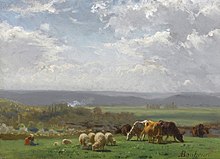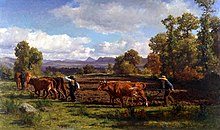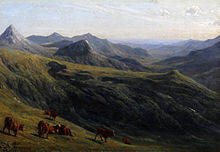| Revision as of 13:19, 24 October 2014 editColdcreation (talk | contribs)Extended confirmed users, Rollbackers24,701 edits →External links: Artcyclopedia, Auguste Bonheur Works Online← Previous edit | Revision as of 13:44, 24 October 2014 edit undoColdcreation (talk | contribs)Extended confirmed users, Rollbackers24,701 edits Corrected date of birth to 3 November 1824 and date of deathNext edit → | ||
| Line 5: | Line 5: | ||
| | caption = Portrait of Auguste-François Bonheur by French photographer ] | | caption = Portrait of Auguste-François Bonheur by French photographer ] | ||
| | birth_name = | | birth_name = | ||
| | birth_date = {{Birth date|1824| |
| birth_date = {{Birth date|1824|11|3|df=yes}} | ||
| | birth_place = ], ] | | birth_place = ], ] | ||
| | death_date = {{Death date and age|1884| |
| death_date = {{Death date and age|1884|2|21|1824|11|3|df=yes}} | ||
| | death_place =], ] | | death_place =], ] | ||
| | nationality = French | | nationality = French | ||
| Line 20: | Line 20: | ||
| }} | }} | ||
| '''Auguste Bonheur''' ( |
'''Auguste Bonheur''' (3 November 1824 in Bordeaux – 21 February 1884 in Bellevue (Seine-et-Oise)<ref></ref> was a French painter of animals and ] scenes in landscapes. He had the ability to depict the horizon, ambience, luminous settings and space. Auguste Bonheur's works during his lifetime were compared to his more successful older sister, the renowned animal painter ], which may have had a negative effect on his career. | ||
| His paintings were influenced by the seventeenth-century cattle paintings by Dutch painters, like ] and ]. Bonheur's paintings enjoyed popularity among British art collectors and, in the Netherlands, the uncle of the famous painter Vincent van Gogh, an art dealer also called Vincent van Gogh, owned one of his paintings. | His paintings were influenced by the seventeenth-century cattle paintings by Dutch painters, like ] and ]. Bonheur's paintings enjoyed popularity among British art collectors and, in the Netherlands, the uncle of the famous painter Vincent van Gogh, an art dealer also called Vincent van Gogh, owned one of his paintings. | ||
Revision as of 13:44, 24 October 2014
| Auguste Bonheur | |
|---|---|
 Portrait of Auguste-François Bonheur by French photographer Adolphe Dallemagne Portrait of Auguste-François Bonheur by French photographer Adolphe Dallemagne | |
| Born | (1824-11-03)3 November 1824 Bordeaux, France |
| Died | 21 February 1884(1884-02-21) (aged 59) Paris, France |
| Nationality | French |
| Education | National School of Fine Arts in Paris |
| Known for | Painting |
| Movement | Realism |
| Awards | Knight of the Legion of Honour |
Auguste Bonheur (3 November 1824 in Bordeaux – 21 February 1884 in Bellevue (Seine-et-Oise) was a French painter of animals and bucolic scenes in landscapes. He had the ability to depict the horizon, ambience, luminous settings and space. Auguste Bonheur's works during his lifetime were compared to his more successful older sister, the renowned animal painter Rosa Bonheur, which may have had a negative effect on his career. His paintings were influenced by the seventeenth-century cattle paintings by Dutch painters, like Aelbert Cuyp and Paulus Potter. Bonheur's paintings enjoyed popularity among British art collectors and, in the Netherlands, the uncle of the famous painter Vincent van Gogh, an art dealer also called Vincent van Gogh, owned one of his paintings.
Life
Auguste Bonheur was the younger brother of the renowned animal painter Rosa Bonheur, and the first son of the painter Oscar-Raymond Bonheur (1796–1849) and his wife Christine Dorotheé Sophie Marquis (1797–1833). His mother died a year after the birth of her last child, Isidore. Raymond Bonheur remarried and moved to Paris in 1829. His daughter, Juliette, born in 1830, also became a painter, and married in 1852 the artist Auguste François Hippolyte Peyrol. The Bonheur family lived in Magny-les-Hameaux in the department of Yvelines. Auguste Bonheur was admitted to the École des Beaux-Arts de Paris in 1848 in the studio of Paul Delaroche. Like his sister Rosa, he became a peintre animalier.
Bonheur preferred the traditional and detailed painting style and received his education at his father's atelier. Bonheur exhibited at the Salon of 1845. In 1852 he won a third-class medal for his landscapes Côtes de Brageac (Cantal) and Environs of Mauriac (Cantal), and a first-class medal in 1861. In the 1860s he made a trip to Scotland. His Highland Scene with Cattle in the Victoria and Albert Museum of 1863 is reminiscent of the scenery of the Scottish lochs.
Bonheur married and had a son named Raymond who became a music composer, and a close friend of Andre Gide and confidant of Claude Debussy. In 1856 Bonheur's painting Mountain Scenery in the Auvergne: Early Morn was shown in Liverpool as part of an exhibition of French painting, along with other works by Auguste and Rosa. This may be the same painting as The Ruins of the Château d’Apchon, exhibited at the Paris Salon in 1853, and purchased by the French minister of the interior, on the advice of Rosa. The minister's painting was bought in 1868 by George Holt of Sudley House under the title Landscape, Auvergne, and is still on display there.
Auguste Bonheur was appointed a Knight of the Legion of Honour in 1867. Bonheur's La Sortie du pâturage, which is 100 by 160 inches (2.5 by 4.1 m) in size, was painted in 1861 and exhibited in the Salon the same year along with his L'Arrivée à la foire, Auvergne (Coming to the Market, Auvergne) and Rencontre de deux troupeaux dans les Pyrénées (Encounter of Two Herds in the Pyrenees). The Sortie was awarded a first class medal, and as a result was included as a prize in a lottery run by the French government in order to promote the ownership of modern art. It was won by Leblois, an employee of the Chemins de fer de l'Est. The painting, together with Auguste's Le Combat, souvenir des Pyrénées, later passed into the ownership of Sir Edward Bates at Gyrn Castle in Flintshire.
The poet and art critic Théophile Gautier visited the Paris Salon in 1861 and noted Auguste Bonheur's three paintings. Writing in Abécédaire du Salon de 1861, Gautier reported on the similarity of style between Bonheur and Rosa, although Auguste's landscape settings were stronger and purer in colour, giving an impression of luminous sunshine. On balance, Gautier favoured the paintings of Rosa Bonheur for their stronger brushwork.
- Auguste Bonheur 's paintings
-
 La Sortie du pâturage (The Return from the Pasture), 1861. Oil on canvas.
La Sortie du pâturage (The Return from the Pasture), 1861. Oil on canvas.
-
 Le Combat, souvenir des Pyrénées
Le Combat, souvenir des Pyrénées
-
 The chief of the heard
The chief of the heard
-
 The Ruins of the Château d’Apchon
The Ruins of the Château d’Apchon
-
 Pasture beside the lake
Pasture beside the lake
-
 Scenery in the Auvergne: Early Morn
Scenery in the Auvergne: Early Morn
-
 Plowing in the Nivernais
Plowing in the Nivernais
-
 Auguste and Rosa Bonheur - Bovins sur une colline
Auguste and Rosa Bonheur - Bovins sur une colline
References
- Centre Historique des Archives Nationale, dossiers de proposition pour la Légion d'honneur 1852-1870
- ^ Sillevis, John. "New Discoveries:Auguste Bonheur's La Sortie du pâturage (The Return from the Pasture), 1861". 19thc-artworldwide.org. Nineteenth Century Art Worldwide (journal). Retrieved 17 October 2014.
- "Highland Scene with Cattle". collections.vam.ac.uk. Victoria and Albert Museum. Retrieved 21 October 2014.
- "Sudley House Morning Room". liverpoolmuseums.org.uk. Liverpool Museums. Retrieved 21 October 2014.
- Rehs, Amy and Alyssa. "Auguste Bonheur". rehs.com. Rehs Galleries Inc. Retrieved 18 October 2014.
External links
- Auguste Bonheur, Joconde, Portail des collections des musées de France, Ministère de la Culture et de la Communication
- Artcyclopedia, Auguste Bonheur Works Online